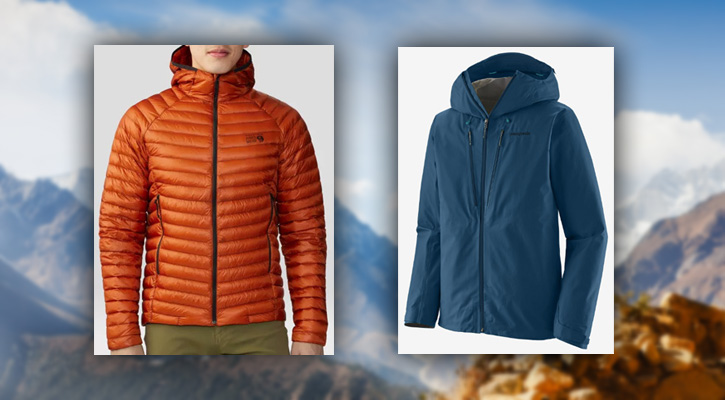
Patagonia is considered a premium brand for its sustainability, performance, and durability while Mountain Hardwear is a great option for quality gear for mountain activities.
For technical mountaineering or climbing gear, Mountain Hardwear would be our recommendation, while Patagonia is a leader in clothing and multi-use outdoor equipment.
But why?
Let’s find out by exploring these brands’ histories, technologies, products, and prices so you can have a better idea of both when the decision time comes!
Contents:
1. Mountain Hardwear Outdoor Gear
History of the Brand
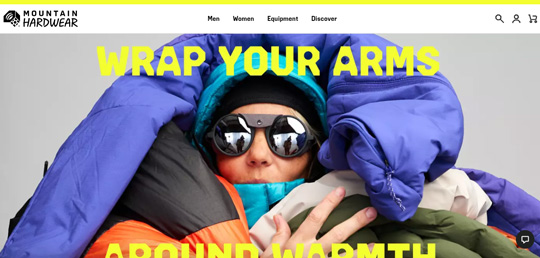
Mountain Hardwear’s official website
The Mountain Hardwear brand originated in California in 1993, founded by former employees of the Sierra Designs brand. Ed Viesturs, the first American athlete to summit fourteen 8000-meter peaks, played a pivotal role in promoting the brand due to his remarkable achievements.
Today, the company maintains its association with Alpine athletes and their expeditions. In 2003, Columbia Sportswear acquired the brand, marking a significant milestone.
The inaugural Mountain Hardwear store was established in Portland, Oregon in 2008, followed by another store in Seattle the same year, signaling the brand’s continuous expansion.
Don’t miss: 8 Brands like Mountain Hardwear: Our Best Alternatives
Materials, Fabrics, and Production Process
Mountain Hardwear is renowned for its utilization of high-quality materials and cutting-edge manufacturing methods, resulting in products that surpass expectations. The apparel ensures exceptional performance for outdoor enthusiasts and athletes.
The mountaineering clothing offers remarkable durability and protects against low temperatures, featuring outstanding thermal insulation. The brand consistently updates its production, enhancing its designs to elevate athletes’ performance.
The parkas, jackets, and other garments incorporate wool and flannel fabrics, offering warmth even in the most extreme conditions. Additionally, their jackets use natural down and fleece (a soft material similar to sheep’s wool, providing warmth while remaining gentle on the skin).
These materials are long-lasting, resilient, maintain consistent body temperature, shield from the wind, and incorporate advanced technology.
Next, Mountain Hardwear employs various fabric technologies such as Pertex Y Fuse, various options of Gore-Tex (Paclite, C-knit backer, Active, etc.), Dyneema Composite fabrics, and more.
PrimaLoft synthetic insulation and Polartec fleece are key components for warmth in their products. The brand also integrates the RECCO® technology, an advanced rescue system, into some of its gear. Sustainability is a pivotal consideration guiding the company’s production processes and business practices.
The video will be loaded from YouTube.com, a third party. If you play it, you accept their terms of service, and their use of cookies.
Read also: 12 Best American Jackets and Outdoor Clothing Brands
Where is Mountain Hardwear outdoor gear made?
Mountain Hardwear’s gear, in addition to other brands owned by Columbia, is mostly manufactured in Asia, specifically in China, Bangladesh, India, Vietnam, etc. (source)
Recommended Products
Mountain Hardwear Men’s Ghost Whisperer/2 Hoody
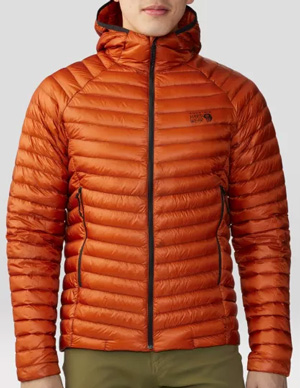
Image: mountainhardwear.com
Check it out at MountainHardwear.com
The Mountain Hardwear Men’s Ghost Whisperer/2 Hoody represents an ultra-light and easily storable down jacket intended for diverse outdoor pursuits. Crafted from 100% recycled nylon, it incorporates 800-fill RDS-certified down for ethical insulation.
Engineered for a regular fit to ensure unrestricted mobility, this garment incorporates practical features such as synthetic insulation at the cuffs, an adaptable hood, and zippered hand pockets. Additionally, it can be packed into its own pocket, enhancing its suitability for travel.
Weighing approximately 8.8 ounces (249 g) for a medium size, this hoody offers both lightness and warmth, boasting a center-back length of 27.5 inches (69.9 cm). It serves as an eco-conscious option for outdoor enthusiasts seeking comfort while minimizing their environmental footprint.
Mountain Hardwear Women’s JMT 25L Backpack
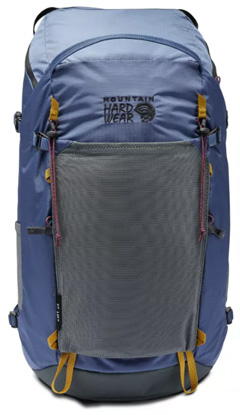
Image: mountainhardwear.com
Check it out at MountainHardwear.com
The Mountain Hardwear Women’s JMT 25L Backpack presents a sturdy and lightweight daypack tailored for outdoor pursuits like hiking and climbing. Crafted with a robust 500D CORDURA base, it is engineered for longevity.
This backpack is specifically contoured for women, incorporating a ventilated mesh back panel and fully cushioned shoulder straps to ensure comfortable transportation. Its clamshell-style opening facilitates easy access to equipment, while the top zippered pocket aids in organizing essentials.
Additionally, side compression straps are included to secure the load, and attachment loops are provided for trekking poles or an ice axe. Offering a minimalist design and indispensable attributes, the JMT 25L is a pragmatic option for day hikers in search of both functionality and ease.
Prices
In general, Mountain Hardwear falls within the mid-to-high price range. Their jackets range from $100 to $1,000 for specialized high-performance styles. The backpacks are priced between $90 for daypacks and $450 for alpine climbing packs.
Are Mountain Hardwear products worth the price?
We love the designs of this brand, and after reviewing online feedback, it’s widely agreed that their items are durable, long-lasting, practical, and exceptionally comfortable. So, the price is worth it, if you ask us.
Must read: 8 Best Sustainable Outdoor Clothing Brands: Our Top Picks
2. Patagonia Outdoor Gear
History of the Brand
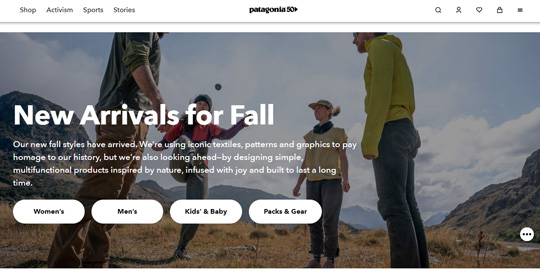
Patagonia official website
The origins of Patagonia can be traced back to 1957 when Yvon Chouinard, a passionate climber, started to learn blacksmithing. In the same year, he crafted his initial pitons and distributed them to fellow climbers.
Later, Chouinard set up a small workshop in Burbank to produce his climbing gear, which he then personally marketed by traveling throughout California.
By 1965, a partnership with Tom Frost led to the formation of Chouinard Equipment. Following the separation of Chouinard Equipment, Chouinard founded Patagonia as a clothing brand in 1973.
Don’t miss:
9 Brands Like Patagonia for Sustainable Outdoor Clothing
12 Best American Jackets and Outdoor Clothing Brands
Materials, Fabrics, and Production Process
Patagonia believes that every individual’s actions have a global impact. The brand uses recycled materials, such as fishing nets, wool, cashmere, polyester, and cotton, in its premium clothing and outdoor gear.
They also incorporate Nylon and Polyester in jackets and coats, along with advanced fabric technologies like H2No and Gore-Tex.
Recycled natural down is used by the company for insulation against cold temperatures when you’re up in the mountains. These materials undergo strict testing before being used in the final product.
Patagonia is famous in the outdoor community for its commitment to sustainability, activism, fair labor practices, and donating a part of its annual revenue to environmental causes. More information about Patagonia’s materials can be found on their official website.
The video will be loaded from YouTube.com, a third party. If you play it, you accept their terms of service, and their use of cookies.
Read also: Eddie Bauer vs Patagonia (Outdoor Gear Comparison)
Where is Patagonia outdoor gear made?
Patagonia’s outdoor equipment is primarily manufactured in Vietnam, China, Sri Lanka, Mexico, Thailand, and various other nations, with a minor part produced in the United States.
Recommended Products
Patagonia Triolet Men’s Jacket
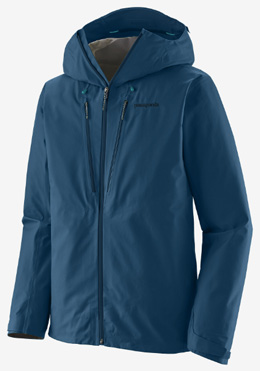
Image: patagonia.com
Check it out at Patagonia.com
The Men’s Triolet Jacket by Patagonia is engineered to endure harsh winter conditions. Constructed from a 3-layer GORE-TEX fabric, it offers waterproof, breathable, and windproof properties, complemented by a 100% recycled polyester exterior for enhanced robustness.
This jacket is PFC-free and is made in a Fair-Trade-certified facility. It features a helmet-compatible hood, two welted front pockets, two chest pockets with watertight zips, and an interior drop-in pocket.
Additionally, it includes welted, watertight two-way pit zips for added ventilation and a dual-adjust drawcord hem to effectively block out the elements. Equipped with a concealed RECCO® reflector for enhanced visibility, this jacket is produced in Vietnam.
Read also: The North Face vs Patagonia: Which is Better?
Patagonia Terravia 28L Pack
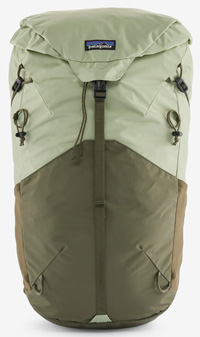
Image: patagonia.com
Check it out at Patagonia.com
The versatile Patagonia Terravia 28L Pack is an excellent choice for day trips or longer hikes. With a 28-liter capacity and durable 100% recycled nylon construction, it offers strength and sustainability. The backpack includes a breathable back panel and shoulder straps, an automatic lid closure system, and a front-loading stuff pocket.
Its suspended mesh back panel design ensures optimal airflow and moisture prevention for maximum comfort. The Regulator® air mesh shoulder straps and hip belt guarantee a comfortable fit, while the easily accessible side pockets and hydration compatibility add convenience.
It also comes with a zippered lid, rain cover, and internal security pockets.
Read next: Jack Wolfskin vs Patagonia Outdoor Gear: A Comparison
Prices
Patagonia is widely regarded as a premium brand within the outdoor enthusiasts’ community. The price of their jackets ranges from approximately $130 to $700, while their backpacks are priced between $70 and $300.
Are Patagonia products worth the price?
We are of the opinion that investing in Patagonia is worth it. The company is dedicated to using sustainable materials, advocating for environmental protection, and delivering long-lasting, quality, high-performance gear.
Learn more: Why Is Patagonia So Expensive and Popular? Are Its Jackets Worth It?
3. Which is Better? Mountain Hardwear or Patagonia?
These are two popular brands when it comes to mountain outdoor activities. Here are a few things to keep in mind when making your decision:
- Quality: Both brands are known for making high-quality and durable outdoor gear. Patagonia has a slight edge for its commitment to sustainability and ethical manufacturing. But Mountain Hardwear also has sustainability programs in place.
- Performance: They’re comparable: both use innovative materials and designs for good weather protection, breathability, and windproofness. Popular technologies include the industry-standard Gore-Tex membranes, Patagonia’s H2No fabrics, and PrimaLoft synthetic insulation.
- Prices: The brands have comparable prices, both being mid-to-high-priced brands. Mountain Hardwear has a few more expensive jacket designs, reaching $1,000.
- Style: Patagonia has more minimalist designs compared to the more colorful looks of Mountain Hardwear.
- Specialization: Mountain Hardwear focuses more on gear for mountaineering, climbing, and winter sports. Patagonia has a wider range of products from outdoor apparel to gear for many activities, including casual wear.
So, in the end, Patagonia is considered a premium brand for its sustainability, performance, and durability while Mountain Hardwear is a great option for quality gear for mountain activities.
For technical mountaineering or climbing gear, Mountain Hardwear would be our choice, while Patagonia is a leader in apparel and multi-use outdoor equipment.
Read next: 9 High-End, Expensive Hiking Brands for Clothing and Footwear
